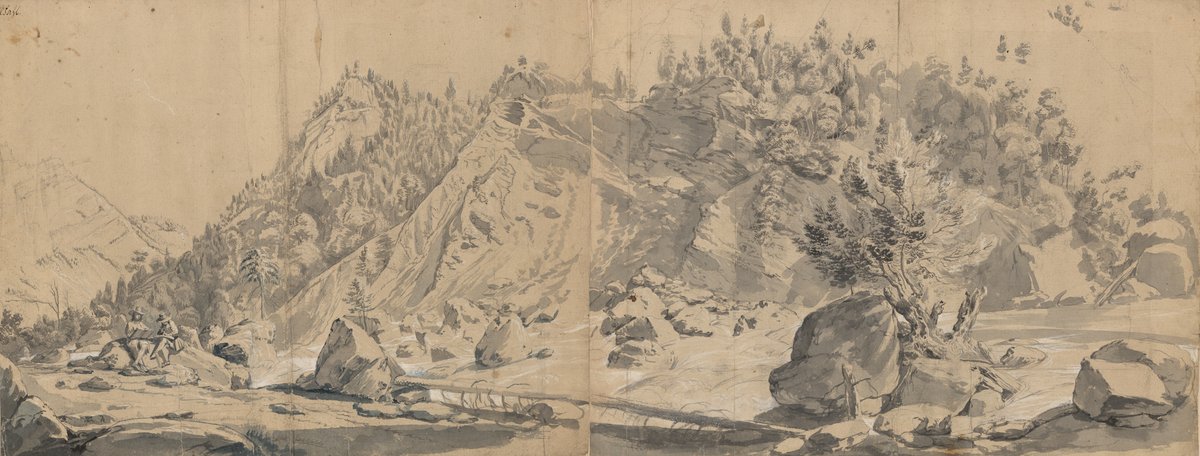The Löntsch Valley in Glarus

Conrad Meyer
Löntschtal in Glarus, 1655
Tuschpinsel in Grau, blau aufgehellt und weiss gehöht, 37,9 × 95,5 cm, Zentralbibliothek Zürich, Graphische Sammlung
This composite drawing, to which the sheet on the right also belongs, is considered an "incunabulum of Swiss landscape painting". These are the first artistic drawings ever to have been created in the Alps and to have the landscape as their subject. Up to this point – and far beyond – the Alps were considered an inhospitable region that had to be overcome above all else. They were scary and threatening, not something that anyone would have wanted to depict in art.
At the beginning of the 17th century, an interest in the Dutch landscape as a motif for painting emerged in the Netherlands. Previously, nature had only been a backdrop for biblical or other stories, if at all, but it did not appear as a subject in its own right. It is therefore no coincidence that the Swiss mountains were also discovered by a Dutchman: in 1655, the Dutch landscape painter Jan Hackaert (1628–1685) undertook a journey to Switzerland and made a longer stay in Zurich, where he became friends with Conrad Meyer. Together they made numerous excursions to the lake and the surrounding countryside. In the summer, they embarked on their biggest and furthest artist's journey to date, which took them to the Glarus Alps. Together they sketched the wild nature of the mountains on location, capturing areas on paper that had never before been seen by artists.
The large view of the Löntsch Valley shown here was created on this tour. The unusually large format forms an actual panorama, and you can follow Conrad Meyer's point of view exactly and turn your head with him. On the left we see Jan Hackaert together with the young painter's pupil Johann Rudolf Werdmüller (1639–1688), sitting on a stone and sketching the area.
What is seen and drawn here is a place that has never been depicted before, a piece of wilderness. It is the panorama of a wild river course in which no civilizing elements appear. There is no town, no church, not even a road that could have served as a starting point. Meyer made the main subject of this extremely ambitious drawing a rock formation which, according to the understanding of the time, could not possibly have been the model for a painting. However, it is also not a detailed study of a tree or a boulder that he could have later inserted into a painting, but shows an entire piece of landscape that was treated in a continuous and pictorial manner. Against this background, the two draughtsmen also become part of it or, read differently, temporary foreign bodies, whose presence reinforces the absence of civilization and thus the sheer wildness of nature.
Meyer was an extraordinary draughtsman who, in addition to his everyday work, which was characterized by diligence and routine, devoted himself to completely new and unknown things in his free time – technically, in terms of content, but also physically. Although his paintings may not always meet international standards, the Löntschtalblätter in particular bear witness to how modern and unbiased he could be. It is significant that this foray into the as yet unpainted Alpine world took place together with a Dutchman, a representative of the country that lifted landscape painting of the time into new spheres. This cultural exchange provided the basis from which, with a spirit of discovery and a genuine artistic interest in new things and nature, such remarkable drawings emerged as had never been created before – veritable pioneering work.


